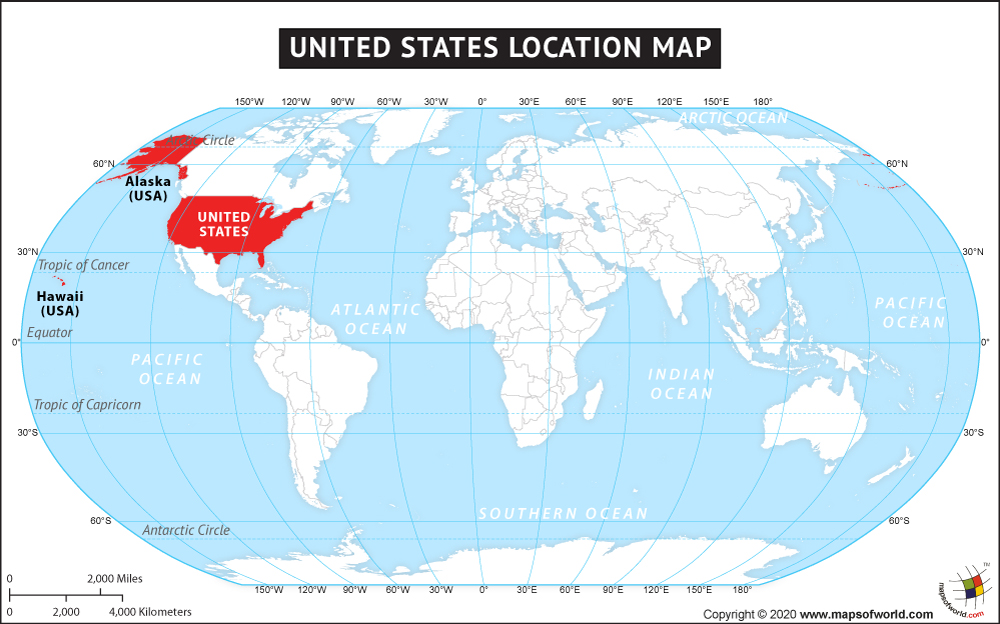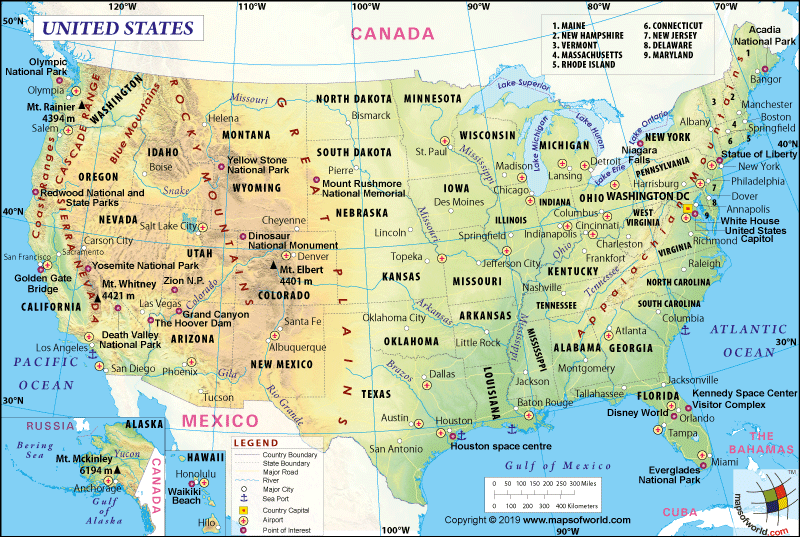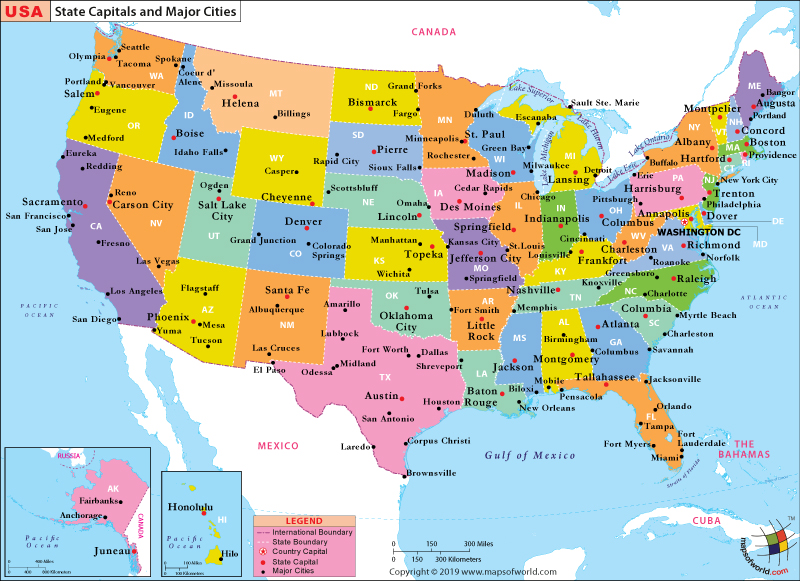US Presidential Election 2020: Why Caucuses are Important for Primary Nominations? Which States have Caucuses & Primaries?
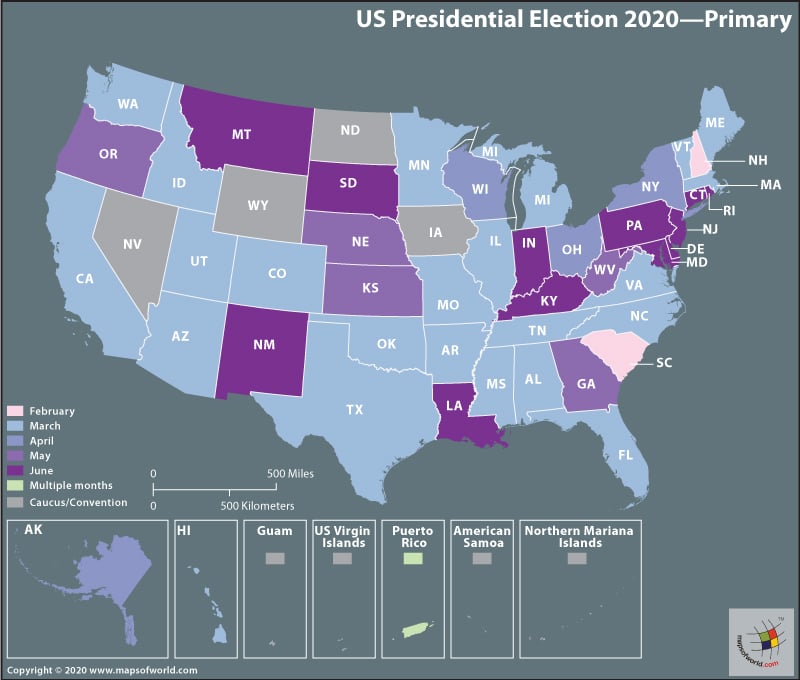
The race for the White House has started. It starts with the process of electing the nominees of the Democratic Party and the Republican Party for the US Presidential election 2020. While it began with the Iowa caucuses on February 3, it will end with the Puerto Rico primary on June 7.
The incumbent US President Donald Trump is going to be the nominee of the Republican Party. Though Trump technically has a challenger, it is going to be a clear run for him because of his widespread popularity among the Republicans. This means that the primaries and caucuses will take place for both the political parties, but the ones worth watching will be the Democratic primaries.
When the US Presidential Democratic nomination started, 28 people (including at least six females) announced that they were running for the Democratic nomination for president. It is believed to be the largest field of presidential candidates for any political party in the US since 1972.
However, the number soon came down to 11 nominees at the beginning of the primaries because of various factors, including inadequate public reaction towards a candidate, dwindling funds for the campaign, campaign infighting, and many more. After the March 4 Super Tuesday, the number has come down to 3 nominees (Joe Biden, Bernie Sanders, and Tulsi Gabbard) now with just two (Joe Biden and Bernie Sanders) having a chance to win.
The primaries and caucuses will be held in 50 US States, 11 US territories, and 1 Democrats Abroad throughout 4-months (February 3 to June 7 tentatively) in 2020.
In 2016, the tally of major candidates was 17 during the Republican Presidential nomination. In the modern history of the US, the field of 2020 Democratic presidential candidates is the largest, as well as the most diverse.
Before going any further and learning about the process of the Democratic nomination process, it is essential to know what the primaries and caucuses are in the first place.
Primary vs. Caucuses: What are they? What are the Differences?
Caucuses
-
The word “caucus” originated in North America during the 1700s. Caucus refers to the meeting of members/supporters of either a political party or a specific movement.
-
Right from the beginning of the democratic and federal political process in the United States of America, caucuses were the most popular forms of electing a candidate. The characteristic feature of this process is that it allowed only members of a political party to meet in one place at a particular time for electing a party nominee.
-
In caucuses, the registered voters (mainly members of a political party) turn up at a few limited locations at certain times and spend some time there. The voters generally attend a meeting (for a few hours) first and then cast their votes (either through a head-count or a show of hands) in favor of their preferred candidates. The meetings usually take place at a few select locations. A voter can’t just turn up at a polling station in caucuses.
-
Caucuses used to be very popular earlier. However, with time the primaries have become more popular. They are held in just four US states (Iowa, Nevada, North Dakota, and Wyoming) in the 2020 US Democratic Presidential nomination election.
-
If any candidate receives less than 15% of the vote in any Caucus, then their supporters can pick up a second choice. Those supporters can either sit out the second vote or vote for a candidate who received over 15% votes.
-
Caucuses are most suitable for candidates who are good at rousing their voters with powerful words and lectures. Two such examples are Bernie Sanders and Pete Buttigieg.
Primaries
-
In the case of primaries, the registered voters will have to turn up at a polling booth and vote in secret. They don’t need to attend any meeting. The primary voters can leave after casting their votes.
How do Primaries and Caucuses Work?
Whether it is a primary or a caucus, the candidates getting more votes are awarded more delegates. The candidates aim to win a majority of delegates. The primary elections take place in all the US states and territories. However, the total number of delegates differs from one state to the other. The allocation of delegates by states is dependent upon a convoluted series of criteria. While California allocates 415 Democratic delegated in 2020, New Hampshire allocated 24 delegates.
During the 2020 US Democratic Presidential nomination, a candidate has to receive at least 15% of the votes polled in a primary or caucus for being awarded delegates. Eight candidates were there in the running initially, and that’s why the votes were shared among the candidates. This is the reason why many candidates failed to receive 15% votes.
The picture of the Democratic Presidential nomination of 2020 has started becoming more explicit, and the two frontrunners are former Vice President Joe Biden and Vermont Senator Bernie Sanders. At the time of writing this article, Joe Biden has 1,201 delegates, and Bernie Sanders has 896 delegates out of the total 2,273 declared delegates. There is a long way to go, and both the contestants are giving their best to win the Democratic nomination for the 2020 US Presidential election.
What are the 2016 Reforms in the Democratic Party’s Primary and Caucus Process?
There was widespread dissatisfaction among the democratic members and voters regarding the election of Hillary Clinton over Bernie Sanders in the primaries during the 2020 US Presidential election and the subsequent loss of Clinton to Republican candidate Donald Trump. This necessitated reforms to make the process of primaries and caucuses more participatory and transparent.
That’s why the member of DNC (Democratic National Committee) passed a set of reforms called “Superdelegate § DNC Unity Reform Commission and superdelegate reform, 2016–2018” on August 25, 2018. It was done to increase participation, on the one hand, and ensuring transparency, on the other.
There were two significant changes done in the process of primaries:
a) Whenever available, the state parties have been encouraged to use a government-run primary.
b) The state parties have been encouraged to increase the accessibility of the primary by enabling the three facilities:
-
-
Same-day registration
-
Automatic registration, and
-
Same-day party-switching
-
There were two significant changes done in the process of caucuses:
-
Caucuses have been required to include the facility of absentee voting.
-
Caucuses have to make arrangements for including those members who can’t participate in person.
The new reforms say that the DNC will handle the outcome of caucuses and primaries in 3 scenarios:
Scenario #1: In case of a candidate winning at least 2,268 pledged delegates, at the first ballot, the superdelegates will be allowed to vote as their influence can’t overturn the majority of pledged delegates.
Scenario #2: In case of a candidate winning 1,886-to-2,267 pledged delegates, at the first ballot, the superdelegates will not be allowed to vote. The first ballot will be decided entirely by the pledged delegates’ will.
Scenario #3: In case of a candidate winning more than 1,885 pledged delegates, it will lead to a contested convention. It will lead to a contested convention, where at the first formal ballot, the superdelegates will not be allowed to vote. However, the superdelegates will regain their right to vote for their preferred presidential nominee for all subsequent ballots that are required for reaching a majority.
After the 2016–2018 reform was implemented, the superdelegates are refrained from voting on the first presidential nominating ballot until and unless a single candidate has already secured over 50% of all delegate votes (through the outcome of caucuses and primaries) among only the elected pledged delegates.
In the last two scenarios (mentioned above), the superdelegates are barred from voting at the first ballot. However, they can publicly endorse a candidate of their choice before the convention.
In case, the majority mark of 1,886 pledged delegate votes are not secured, all the superdelegates will regain their right of voting on any subsequent necessary ballot so that the presidential candidate can be nominated by receiving a majority of 2,267 votes.
In the state level, there were many changes in the nomination process:
-
After 2016, the total number of caucuses dropped significantly. The states such as Idaho, Nebraska, Kansas, Hawaii, Minnesota, Colorado, Washington, and Maine have decided to change their Democratic Party nomination process from caucuses to primaries. In the recent history of the Democratic Party, 2020 saw the lowest number of caucuses. Only three US states (including Wyoming, Nevada, and Iowa) and four US territories (American Samoa, Guam, US Virgin Islands, and Northern Marianas) have used the caucuses.
-
The ranked-choice voting system in the primaries has been adopted for all voters in Wyoming, Kansas, Hawaii, and Alaska. DNC approved it in 2019. The DNC has approved the ranked-choice voting system for absentee voters in 2019. This system doesn’t eliminate candidates until a single winner is chosen. It reallocates voters’ choices till all remaining candidates have at least 15% (the threshold for receiving delegates to the convention).
Tentative Primary and Caucus Calendar of US Presidential Nomination Process (Democratic/Republican)
This is the complete primary/caucus calendar of the US Presidential Nomination Process for both Democratic and Republican Parties (until and unless stated otherwise due to some emergency such as COVID-19 coronavirus crisis).
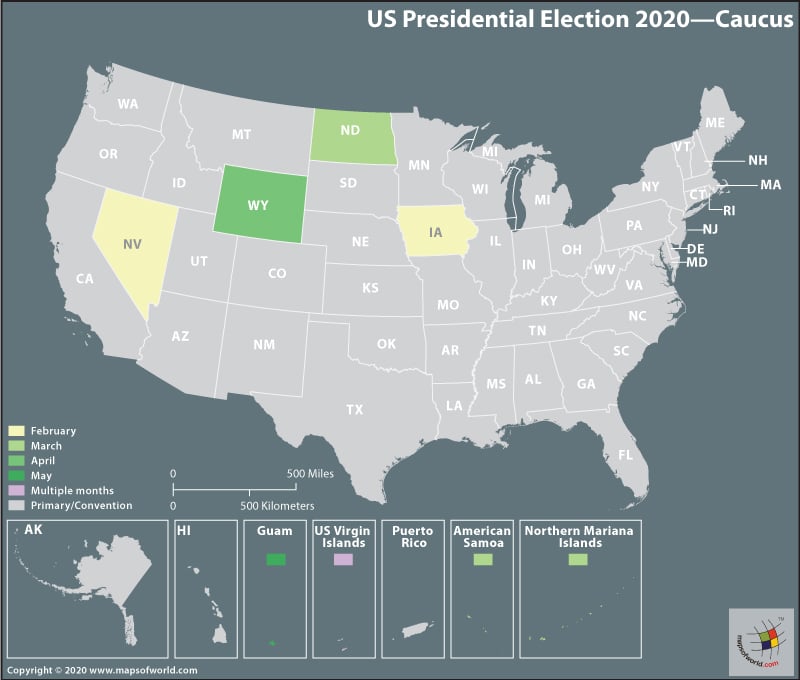
FEBRUARY 2020
-
February 3 (Monday): Iowa caucuses (Democratic, Republican)
-
February 11 (Tuesday): New Hampshire (Democratic, Republican)
-
February 22 (Saturday): Nevada (Democratic)
-
February 29 (Saturday): South Carolina (Democratic)
MARCH 2020
-
March 3 (Tuesday) – Super Tuesday
-
Alabama (Democratic, Republican)
-
American Samoa caucuses (Democratic)
-
Arkansas (Democratic, Republican)
-
California (Democratic, Republican)
-
Colorado (Democratic, Republican)
-
Maine (Democratic, Republican)
-
Massachusetts (Democratic, Republican)
-
Minnesota (Democratic, Republican)
-
North Carolina (Democratic, Republican)
-
Oklahoma (Democratic, Republican)
-
Tennessee (Democratic, Republican)
-
Texas (Democratic, Republican)
-
Utah (Democratic, Republican)
-
Vermont (Democratic, Republican)
-
Virginia (Democratic)
-
Democrats Abroad (Democratic)
-
March 10 (Tuesday)
-
Idaho (Democratic, Republican)
-
Michigan (Democratic, Republican)
-
Mississippi (Democratic, Republican)
-
Missouri (Democratic, Republican)
-
North Dakota caucuses (Democratic)
-
Washington State (Democratic, Republican)
-
March 12 (Thursday): Virgin Islands caucuses (Republican)
-
March 14 (Saturday)
-
Guam caucuses (Republican)
-
Northern Marianas (Democratic)
-
March 17 (Tuesday)
-
Arizona (Democratic)
-
Florida (Democratic, Republican)
-
Illinois (Democratic, Republican)
-
Northern Mariana’s caucuses (Republican)
-
Ohio (Democratic, Republican)
-
March 24 (Tuesday)
-
American Samoa caucuses (Republican)
-
Georgia (Democratic, Republican)
-
March 29 (Sunday): Puerto Rico (Democratic)
APRIL 2020
-
April 4 (Saturday)
-
Alaska (Democratic)
-
Hawaii (Democratic)
-
Louisiana (Democratic, Republican)
-
Wyoming caucuses (Democratic)
-
April 7 (Tuesday): Wisconsin (Democratic)
-
April 28 (Tuesday)
-
Connecticut (Democratic, Republican)
-
Delaware (Democratic, Republican)
-
Maryland (Democratic, Republican)
-
New York (Democratic, Republican)
-
Pennsylvania (Democratic, Republican)
-
Rhode Island (Democratic, Republican)
MAY 2020
-
May 2 (Saturday)
-
Guam caucuses (Democratic)
-
Kansas (Democratic)
-
May 5 (Tuesday): Indiana (Democratic, Republican)
-
May 12 (Tuesday)
-
Nebraska (Democratic, Republican)
-
West Virginia (Democratic, Republican)
-
May 19 (Tuesday)
-
Kentucky (Democratic, Republican)
-
Oregon (Democratic, Republican)
JUNE 2020
-
June 2 (Tuesday)
-
District of Columbia (Democratic, Republican)
-
Montana (Democratic, Republican)
-
New Jersey (Democratic, Republican)
-
New Mexico (Democratic, Republican)
-
South Dakota (Democratic, Republican)
-
June 6 (Saturday): Virgin Islands caucuses (D)
-
June 7 (Sunday): Puerto Rico (R)
What happens after the Primaries and Caucuses?
Convention
The announcement of a political party’s (Republican/Democrat) nominee is made in the conventions of the respective parties.
In Case of Republicans
Donald Trump is almost certain to become the Republican nominee for the 2020 US Presidential election. The official nomination of the Republican Party will be announced at the party’s convention to be held during August 24-27, 2020, in Charlotte (North Carolina).
In Case of Democrats
Once the primaries and caucuses in all the US States and territories are over, the US Presidential candidate for the Democrats will be confirmed at the convention held in Milwaukee (Wisconsin) during July 13-16, 2020.
What happens in the Conventions?
It is in these conventions where the role of the delegates (awarded to the candidates during the voting process) comes in. The delegates won by the candidates cast their votes during the convention.
Let us suppose that a candidate won 10 delegates during the voting process in the primaries or caucuses. During the convention, these delegates vote for their candidate to choose the latter as their nominee for the US Presidential election. Generally, the local political leaders or party activists tend to become delegates. To become a delegate, any party member can become one.
In the Democratic primary and caucus elections, a total of 3,979 delegates are allocated to the candidates. These are two scenarios that can emerge:
Scenario #1:
A candidate becomes the official nominee of the party if he wins more than 50% of the delegates or 2,376 delegates. No second voting is required in this stage.
Scenario #2:
In case, a candidate wins more than 50% of the awarded delegates during the primary voting process; the individual will be named as the party’s official nominee at the convention after the vote.
The convention becomes “contested” or “brokered” when none of the candidates have got more than 50% of the delegates. In that case, a second vote would take place. During this second voting process, the votes will be cast by all the 3,979 delegates. However, in this scenario, around 771 “superdelegates” will also cast their votes along with the 3,979 delegates.
The superdelegates are the senior officials of the party (both past and present). It includes high profile officials such as former US President Bill Clinton, the incumbent Vermont Senator Bernie Sanders, and many more, and they can vote for any candidate they wish.
Change in the Rule of Convention in 2020
Earlier, the superdelegates used to vote along with the delegates at the start of the convention. In the 2016 US Presidential election, many superdelegates had pledged their support to Hillary Clinton even before the convention was held. Bernie Sanders (who lost to Hillary Clinton in the last Presidential election by a slender margin) had suggested that the deck was stacked against him because of this rule. Bernie campaigned against this rule and changed it in the 2020 Democratic nomination process.
2020 US Presidential Election
Once the nomination of the candidates is finalized in the Republican and Democratic conventions, the only step that will be left is the presidential election, which is scheduled to be held on November 3, 2020.
Related Links:
